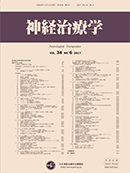Volume 38, Issue 5
Displaying 1-18 of 18 articles from this issue
- |<
- <
- 1
- >
- >|
-
2021Volume 38Issue 5 Pages 697
Published: 2021
Released on J-STAGE: May 31, 2022
Download PDF (192K)
-
2021Volume 38Issue 5 Pages 699-707
Published: 2021
Released on J-STAGE: May 31, 2022
Download PDF (9450K)
-
2021Volume 38Issue 5 Pages 708-714
Published: 2021
Released on J-STAGE: May 31, 2022
Download PDF (4650K) -
2021Volume 38Issue 5 Pages 715-718
Published: 2021
Released on J-STAGE: May 31, 2022
Download PDF (448K) -
2021Volume 38Issue 5 Pages 719-722
Published: 2021
Released on J-STAGE: May 31, 2022
Download PDF (403K) -
2021Volume 38Issue 5 Pages 723-727
Published: 2021
Released on J-STAGE: May 31, 2022
Download PDF (504K) -
2021Volume 38Issue 5 Pages 728-731
Published: 2021
Released on J-STAGE: May 31, 2022
Download PDF (439K) -
2021Volume 38Issue 5 Pages 732-735
Published: 2021
Released on J-STAGE: May 31, 2022
Download PDF (362K) -
2021Volume 38Issue 5 Pages 736-739
Published: 2021
Released on J-STAGE: May 31, 2022
Download PDF (439K) -
2021Volume 38Issue 5 Pages 740-743
Published: 2021
Released on J-STAGE: May 31, 2022
Download PDF (370K) -
2021Volume 38Issue 5 Pages 744-747
Published: 2021
Released on J-STAGE: May 31, 2022
Download PDF (434K) -
2021Volume 38Issue 5 Pages 815-818
Published: 2021
Released on J-STAGE: May 31, 2022
Download PDF (332K)
-
2021Volume 38Issue 5 Pages 748-751
Published: 2021
Released on J-STAGE: May 31, 2022
Download PDF (498K) -
2021Volume 38Issue 5 Pages 752-756
Published: 2021
Released on J-STAGE: May 31, 2022
Download PDF (1236K) -
2021Volume 38Issue 5 Pages 757-760
Published: 2021
Released on J-STAGE: May 31, 2022
Download PDF (1114K)
-
2021Volume 38Issue 5 Pages 761-814
Published: 2021
Released on J-STAGE: May 31, 2022
Download PDF (11306K)
-
2021Volume 38Issue 5 Pages 819
Published: 2021
Released on J-STAGE: May 31, 2022
Download PDF (109K) -
2021Volume 38Issue 5 Pages 820
Published: 2021
Released on J-STAGE: May 31, 2022
Download PDF (141K)
- |<
- <
- 1
- >
- >|
